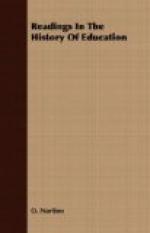During the twelfth and thirteenth centuries the intellectual life of western Europe was enriched by the addition of a group of books, old and new, which were destined to influence profoundly the growth of the universities, as well as the whole course of mediaeval life and thought. Without some such addition to the stock of learning higher education could hardly have developed at all, for the materials available for it previous to the twelfth century were decidedly scanty. The books presently to be described furnished a body of advanced and solid instruction, suited to the needs of the times. They formed one of the permanent influences which both developed and maintained centers of higher education, for the new learning was not less potent in attracting students than the fame of individual teachers or the new method of study.
The greater number of the books which formed the body of university instruction were recoveries from the mass of ancient and long-disused Greek and Roman learning, together with a few works of Arabic and Jewish origin. To this group belong the works of Aristotle, the body of Roman Law, and the medical works of Galen, Hippocrates, and various Arabic and Jewish physicians. In the main, these had been hitherto unknown in western Europe, or at least practically for-gotten since the days of the Roman Empire. In the twelfth and thirteenth centuries they were collected and made generally accessible to students. Those not originally written in Latin were now translated into Latin; manuscript copies were multiplied and widely diffused.
But the intellectual activity of the times accomplished much more than the recovery of some fragments of ancient learning; it also created two new fields of study,—Scholastic Philosophy and Theology, and Canon Law,—and produced the text-books which marked them off as distinct and professional studies. The book which established the method of these studies was Abelard’s “Yes and No” (see p. 20); but the works which furnished the substance of university instruction were, in Theology, the “Sentences” (Sententiae) of Peter Lombard, and in Canon Law, the “Decree” (Decretum) of Gratian, which was also known as the “Harmony of Contradictory Canons” (Concordia Discordantium Canonum), and additions thereto, indicated on page 56.
Thus, during the twelfth and thirteenth centuries, the growth of universities was stimulated by the development of a great body of learning hitherto inaccessible or unknown. The striking nature of this development will be clearer if we recall that no addition to the learning of western Europe in the least degree comparable to this had been made during the entire seven centuries preceding.




